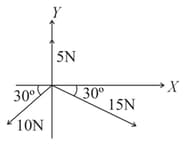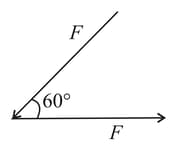Equilibrium
Equilibrium: Overview
This topic covers concepts such as Resultant Force, Principle of Transmissibility of a Force, Parallelogram of Forces, Resolution of a Force into two Perpendicular Components, Resultant of the Forces at a Point, and Lami's Theorem.
Important Questions on Equilibrium
A force of and a force of acting simultaneously at a point may produce a resultant force of
A body of mass is kept on a rough horizontal surface (friction coefficient ). A person is trying to pull the body by applying a horizontal force but the body is not moving. The force by the surface on the body is where
A object is subjected to two forces and . The magnitude of resulting acceleration in will be
Find the magnitude of the resultant of shown forces in plane.

A ball of mass is thrown vertically upwards by applying a constant force by hand. If the hand moves while applying the force and the ball goes upto height further, find the magnitude of the force. Consider .
A balloon of gross weight Newton is falling vertically downward with a constant acceleration . The magnitude of the air resistance is (Neglecting buoyant force)
A body of mass is acted upon by a force and the acceleration produced is . If three coplanar forces each equal to and inclined to each other at act on the same body and no other forces are acting. The acceleration produced will be:
A body is moving under the action of two forces . For its velocity to become uniform a third force acts on it, then this force can be given by:
The sum of the magnitudes of two forces acting at a point is . The resultant of these forces is perpendicular to the smaller force and has a magnitude of . If the smaller force is of magnitude , then the value of is,
The engine of a car produces an acceleration of in the car. If this car pulls another car of the same mass, then the acceleration would be,
A body is under the action of two mutually perpendicular forces of 3 N and 4 N. The resultant force acting on the body is
The sum of the magnitudes of two forces acting at a point is and the magnitude of their resultant is . If the resultant is at with the smaller force, the magnitude of the forces in are
A boy is hanging from a horizontal branch of a tree. The tension in the arms will be maximum when the angle between the arms is
Two forces and are acting at right angles to each other. Then their resultant is
The resultant of two forces, each , acting at an angle θ is
Two forces, each equal to , act as shown in figure. Their resultant is

A body of mass is acted upon by two perpendicular forces and The magnitude and direction of the acceleration of the body respectively are:
A force is inclined at to the horizontal. If its component in the horizontal direction is then magnitude of the vertical component of force is approximately:
A force is inclined at to the horizontal. If its rectangular component in the horizontal direction is , then magnitude of the force in the vertical direction is
A man, using a 70 kg garden roller on a level surface exerts a force of 200 N at 45 to the ground. What is the vertical force of the roller on the ground, if he pushed the roller? ()
